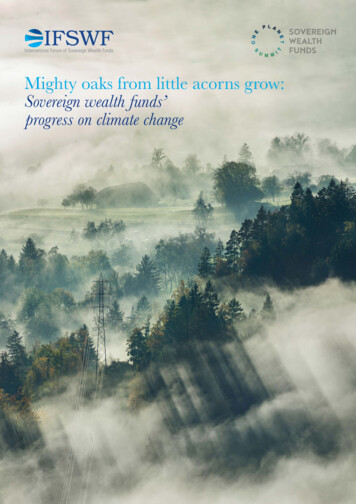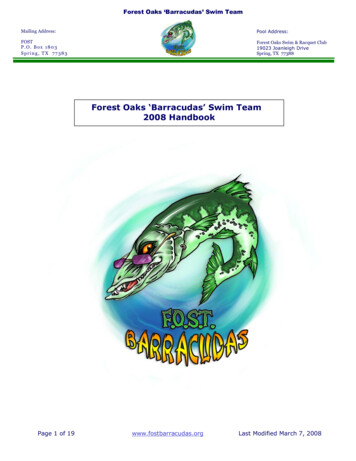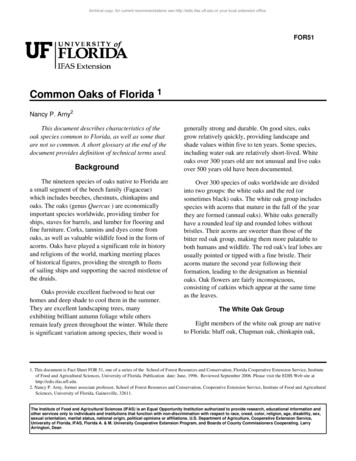
Transcription
Mighty oaks from little acorns grow:Sovereign wealth funds’progress on climate change
Sovereign wealth funds’ progress on climate changeMessage fromIFSWF andOPSWF2The first time that the International Forum ofSovereign Wealth Funds (IFSWF) discussed thefinancial impact of climate change was at our 2016annual meeting Investing in a Climate of Change hostedby the New Zealand Superannuation Fundin Auckland.For many of our members, this was the first time they had considered this issue in anydepth and they had many questions around why this topic was relevant to them, howit would affect their portfolio and whether they needed to implement measures tointegrate the risks and opportunities into their investment process.Fast forward four years, and it is noticeable how much progress has been made. Lessthan a year after the IFSWF meeting in Auckland, six of the world’s largest sovereignwealth funds formed the One Planet Sovereign Wealth Funds (OPSWF), under theauspices of the One Planet Summit and the Élysée Palace. These institutions pledgedto focus on the issue of climate change and work towards creating a set of principlesto apply across their portfolios. Less than a year later, they published the OPSWFFramework. In 2019 a group of the world’s largest asset managers that counted theOPSWF members among their biggest clients came together to support the design andintegration of climate-related strategies, methodologies and indicators. In 2020, theOPSWF Network expanded to 14 sovereign wealth funds, 14 asset managers and fiveprivate investment firms, with a combined 30 trillion assets under management andownership, all of whom are working towards implementing the Framework.This progress has also been noticeable in sovereign wealth funds’ investment behaviour.IFSWF’s database shows that sovereign wealth fund investments in agritech, forestry andrenewables increased almost six-fold from eight investments valued at 324 million in2015 to 18 investments valued at 2 billion in 2020, a total of over 5 billion invested overthe last five years. In 2020, amid the challenges of the coronavirus pandemic, investors’focus on environmental, social and governance issues (ESG), including climate change,has intensified.In response, and with a lack of systematic evidence from across the sovereign wealthfund industry, IFSWF and OPSWF launched a unique survey to shed light on sovereignwealth funds’ attitudes to climate change and how they integrate it into their investmentand governance processes.In September 2020, we circulated a wide-ranging, first-of-its-kind survey to all IFSWFand OPSWF members to analyse whether and how they perceive climate changeconsiderations as aligned with their investment horizons in their decision-making;exercise their ownership rights to encourage companies to address material climatechange issues, and integrate climate change considerations into their investmentprocess. These key topics reflect the three pillars of the OPSWF Framework.For the first time, in this report, we can provide evidence of how sovereign wealthfunds think about climate change and implement related strategies. We also providerecommendations about how sovereign wealth funds can further manage theclimate-related risks and opportunities and strive for sustainable value creation forcurrent and future generations of their citizens. We will continue to work with ourmembers to facilitate open discussion on these and related topics, to strengthen thecommunity. We hope that this survey promotes a deeper understanding of sovereignwealth fund activity on this important topic.
Sovereign wealth funds’ progress on climate changeExecutiveSummary3This report presents the findings from the firstcomprehensive survey of sovereign wealth funds’attitudes to climate change, launched in September2020. The findings represent the responses from 34sovereign wealth funds from around the world andadditional interviews. Given their size and influencein the financial system, these institutions can scaleup and accelerate the transition to a low-carboneconomy, while managing the investment portfoliorisks and opportunities posed by climate change.The report demonstrates that there is a broad consensus among sovereign wealth fundsthat they – and other investors – need to take immediate action to mitigate the effectsof climate change: 93% recognise that climate change is a risk and/or opportunity fortheir portfolios. The majority also agree that financial markets are under-pricing climatechange risks and that unchecked climate change will leave future generations of theircitizens worse off.Eighty-eight per cent of sovereign wealth funds surveyed claimed to take climate changeinto account in their investment processes in some way, though the survey highlightssome sharp differences in how systematic and sophisticated these approaches are.Slightly more than a third of respondents (36%) currently have a formal climate changestrategy in place. Of these, 55% have adopted these policies since 2015, with 30% havingintroduced policies since 2018. Although most of the attention to the issue appearsnascent, a few early adopters, notably New Zealand Superannuation Fund and NorgesBank Investment Management, have been on this journey for more than ten years.Encouragingly, 60% of sovereign wealth funds report that Board or CEO-level executivesare now responsible for climate change within their organisations, demonstrating thatthe majority recognise the strategic importance of the topic. Further, 30% of respondinginstitutions have more than 10% of their portfolios invested in climate-relatedstrategies, suggesting some funds are indeed shifting capital, although there is scopefor accelerating action.The report reveals that many sovereign wealth funds are focused on findingopportunities in climate solutions such as renewable energy generation, energy efficiencyprojects and low-emission transport that have a present-day investment case and returnprofile. Approximately three-quarters of respondents that pursued opportunities relatedto the low-carbon economy thought these sectors would yield the best returns over time.More than half report undertaking climate-related engagement with portfolio companies,while 14% have divested based on environmental considerations.The survey also revealed that sovereign wealth funds are currently focusing their climatechange efforts on real assets, such as property and infrastructure, and privately heldcompanies, while multi-asset, and/or whole portfolio approaches, are still rare.
Sovereign wealth funds’ progress on climate change4The survey highlighted two main barriers to action: finding appropriate data on whichto base decisions and convincing stakeholders of the business case for action. On thefirst point, OPSWF members recently signed a joint statement calling for enhancedclimate-related financial disclosure, adding their voice to the growing internationalmovement to improve the quantity and quality of climate-related financial data. On thesecond, it is encouraging to note that only 10% of sovereign wealth funds surveyedexpect climate strategies to lead to negative returns in the short term and just 3%expected long-term negative returns from implementing such strategies. Forty-threeper cent expect positive long-term returns. We surmise that evidence for the businesscase and stakeholder buy-in could be enhanced if sovereign wealth funds improve theirreporting on the issue; over half of respondents do not publicly disclose any informationon their climate change approach.Overall, the survey shows that sovereign wealth funds are increasingly consideringclimate risks and opportunities in their investment decisions. However, they could bemore ambitious and systematic in their approaches. A few early movers demonstratehigh levels of sophistication, whereas the majority are taking tentative – but important –steps in the right direction.We will repeat the survey at the end of 2021 and hope to see more sovereign wealth fundsapply a more strategic and systematic approach to climate change in their portfolios.Six recommendations arise from the survey findings:1. Adopt and implement climate-related policies. This should includea commitment to take action in integrating material climate risks andopportunities in core investment decision-making. The OPSWF Frameworkprovides common principles from which to begin.2. Seek out the appropriate talent and expertise. This will help thedesign and implementation of a strategy for the integration of climate risksand opportunities, and the development of a strong financially focusedbusiness case for action.3. Explore board member and executive education. This will help expeditethe adoption and communication of such strategies and is particularly importantwhere these individuals are directly responsible for the approach taken.4. Use metrics to show not only climate impact (i.e. success in reducingcarbon exposure) but also comparable returns and risk reduction. This willestablish precedence and evidence for others to follow, as well as increasestakeholder buy-in.5. Communicate to all stakeholders the strategic importance of climatechange. This should include engagement with asset managers and portfoliocompanies to outline climate-related expectations where appropriate. Sovereignwealth funds should also be transparent in reporting of policies and metricsto safeguard reputations and send market signals.6. Partner with peers and international initiatives to share experience andgenerate greater leadership from within the sovereign wealth fund community.
Sovereign wealth funds’ progress on climate changeAbout theSurvey5For this report, we launched the first comprehensivesurvey to specifically examine sovereign wealthfunds’ attitudes to climate change and how theyintegrate these considerations into their investmentand governance decision-making processes. Surveyresponses are further supplemented by interviews.We believe that the results represent a decisive and accurate view of how this investorgroup approaches climate change.In September 2020, we distributed the survey to 42 sovereign wealth funds – thecombined membership of IFSWF and OPSWF. Thirty four institutions (81%) responded.These responses represent the views of 43% of the world’s 78 sovereign wealth funds.While the survey was anonymous – so we do not know which institutions completedthe survey – the distribution list included all the world’s largest sovereign wealth fundswith total assets under management of more than 5.5 trillion, approximately 90% ofsovereign wealth funds’ total assets under management, according to IFSWF’s database.The respondent institutions broadly represented the total geographical distributionof sovereign wealth funds, as shown in the chart below.Geographical Distribution of Respondents*West Asia & North Africa21%Europe18%Sub-Saharan Africa15%Central Asia12%South Asia9%North America9%East Asia9%Oceania6%Chart doesn’t total 100% due to rounding*
Sovereign wealth funds’ progress on climate changeIntroduction:Why climatechange mattersfor sovereignwealth funds6Climate change is already occurring more rapidlyand more severely than expected, affecting societies,ecosystems, economies and portfolios. The 2020World Economic Forum Global Risks Reportranks the failure to act on climate change and theexperience of more frequent and more severe extremeweather as the most significant economic threatsfacing the international community.1 At a time whenthere is heightened attention to systemic risk fromthe Covid-19 pandemic, financial institutions cannotafford to ignore the systemic risk from climate change.According to overwhelming scientific consensus, greenhouse gases created by humanactivity have caused much of the observed increase in global temperatures over the past100 years.2 Since the industrial revolution began in the late 1800s, global temperatureshave risen approximately 1.2 C on average, an order of magnitude more than it rose inthe previous 65 million years.3 Globally, in records dating back to 1850, the warmest sixyears have all occurred since 2015.4 Warming will occur in some regions more rapidly thanothers; for example, and importantly, the Arctic is predicted to warm three times fasterthan the global mean.5 Indeed, significant warming in the Arctic has already been observed,as temperatures north of the Arctic Circle in Siberia hit a new high of 38 C in June 2020,and average Arctic temperatures were 5 C above average in 2020, according to the WorldMeteorological Organization.6 This warming could lead to a global tipping point, beyondwhich reversing catastrophic climate change becomes increasingly impossible.7Scientists and global governments have agreed that, to avoid the worst and mostirreversible effects of climate change in the future, global average temperature riseshould be kept “well below 2 C” and ideally to 1.5 C by the end of the century. To achievethis goal, the world needs to take urgent action. The associated emissions pathwayto 1.5 C requires halving carbon dioxide (CO2) emissions from 2010 levels by 2030and reaching net-zero by 2050, as well as reducing other greenhouse gas emissions.8Ahead of the COP26 meeting of global leaders to be hosted by the UK Governmentin November 2021, governments, companies and financial institutions alike are beingencouraged to ratchet up their commitments and action to support these goals.91 World Economic Forum Global Risk Report 20202 Myles R. Allen et al., Global Warming of 1.5 ºC, International Panel on Climate Change3 Peter Siegmund et al., “The Global Climate in 2015-2019,” World Meteorological Organization, 2019;Noah S. Diffenbaugh and Christopher B. Field, “Changes in ecologically critical terrestrial climate conditions,”Science, August 2013, Volume 341, Number 6145; Seth D. Burgess, Samuel Bowring, and Shu-Zhong Shen,“High-precision timeline for Earth’s most severe extinction,” Proceedings of the National Academy of Sciences,March 2014, Volume 111, Number 94 Ibid5 Myles R. Allen et al., Special report: Global warming of 1.5 C, IPCC, 20186 2020 on track to be one of three warmest years on record, World Meteorological Organization7 Timothy Lenton et al. Climate tipping points – too risky to bet against, Nature, 28 November 20198 “Net-zero” refers to a balance of emissions released into and removed from the atmosphere. A net-zeropathway requires reducing most emissions and then using natural or chemical carbon sinks to remove theremaining excess carbon from the atmosphere. Myles R. Allen et al., Special report: Global warming of 1.5 C,IPCC, 20189 For more information see: https://ukcop26.org/
Sovereign wealth funds’ progress on climate change7As the climate changes, all financial portfolios will face a myriad of direct and indirectthreats to both short- and long-term value creation. In 2015, the Bank of England identifiedthree major climate-related factors that pose a systemic risk to financial stability:10 Physical Risk: Extreme weather events such as hurricanes, drought and floodingcontinue to increase in both intensity and frequency. As well as extreme temporaryevents, chronic physical climate effects will also materialise through the sustainedshift of ecosystems from changes in temperature, precipitation and sea-level rise.No supply chain, community or country is immune from the physical hazards thataccompany climate change, and the financial, human and natural impact of these risksis already significant. Transition Risk: The financial risks that could result from the process of local,national and international adjustment towards a lower-carbon economy. Changesin policy, technology and physical risks could prompt a reassessment of the valueof a large range of assets as costs and opportunities from climate change becomeapparent. The rising relative cost of fossil fuel against renewable generation is alreadyevidence of this shift, and this risk is likely to increase rapidly as governments andconsumers increase their commitment to tackling climate change. Liability Risk: These are impacts that could arise if parties who have suffered lossor damage from the effects of climate change seek compensation. Such claims arestarting to emerge but are increasingly likely as attribution science and physical risksincrease in the coming years and decades. Liability risk has the potential to hit carbonextractors and emitters – and, if they have liability cover, their insurers – the hardest.Legal action against asset owners and governments failing to act on climate changehas also begun in some jurisdictions,11 with potential reputational, governance andfinancial impacts.As large, long-term providers of capital to the economic system, sovereign wealth fundsare exposed directly and indirectly to these risks, with financial implications for theirportfolios and the societies they serve. How these risks play out over the short, mediumand long term will vary based on each sovereign wealth fund’s exposure to different assetclasses, geographies, sectors and companies. Enhanced analysis of portfolio emissionsand vulnerability to these risks could aid risk management and the identification ofinvestment opportunities.Sovereign wealth funds have an important role to play in the transition towards alow-carbon economy that could limit future climate risk. Emerging climate-relatedopportunities are likely to benefit from growing demand as climate policies changeand consumer behaviour shifts, with a 2016 International Finance Corporation reportidentifying a 23 trillion market for opportunities in climate-smart investments inemerging markets by 2030.12 An analysis by the United Nations Framework Conventionon Climate Change put the global financing gap for the low-carbon transition asranging from 1.6 trillion to 3.8 trillion annually between 2016 and 2050.13 Theseassessments demonstrate the scale of the challenge, but also the scale of the investmentopportunities available. Companies can develop new financial and business models todeliver the next wave of climate solutions from transport and waste, to agriculture andenergy storage. But they will require more long-term, patient capital to succeed.10 Mark Carney, “Breaking the Tragedy of the Horizon – climate change and financial stability”,Speech given at Lloyd’s of London 29 September 201511 Joana Setzer, Rebecca Byrnes, Global trends in climate change litigation: 2020 snapshot, Grantham ResearchInstitute on Climate Change and the Environment and Centre for Climate Change Economics and Policy,London School of Economics and Political Science12 International Finance Corporation, Climate Investment Opportunities in Emerging Markets, December 201913 Bridging the Gap in Climate Finance: The Untapped Potential of Investing in Short-Lived Climate PollutantMitigation in Developing Countries Climate & Clean Air Coalition
Sovereign wealth funds’ progress on climate change8Climate change and the low-carbon transition will create winners and losers in everysector and asset class. Integrating these factors into investment decision-making can,therefore, contribute to the protection of long-term value. Many investors, includingsovereign wealth funds, have been doing just that, with investment flows into climatesolutions reaching record highs of 501.3 billion in 2020.14 This survey seeks to shedlight on the views and actions of sovereign wealth funds as they navigate these trends.For many investors, increasing attention to climate change requires the developmentof new internal capacity, policies and investment methodologies, but the risk of failingto do so is great. The physical risks of climate change are manifesting globally at thesame time as the world community rapidly scales up its climate actions: most leadingeconomies have now committed to net-zero pathways by the middle of the century,including the United Kingdom, France, Japan and South Korea. The United States andthe European Union are likely to make similar pledges in 2021.It is no longer a question of “if climate change will affect portfolios”, it is a question ofhow. As the world begins its recovery from Covid-19, sovereign wealth funds could usethis momentum of global reset and reflection to fast-track the integration of climatechange risks and opportunities to protect portfolio returns and reduce systemic financialrisk. This could help national economies to “build back better” and improve resiliencewithin the global financial, economic, environmental and social systems to reduce thelikelihood of future climate-related shocks.14 Energy Transition Investment Hit 500 Billion in 2020 – For the First Time, Bloomberg New Energy Finance
Case Study9New Zealand Superannuation Fund’s Climate Change StrategyClimate change is one of the most defining and complex issuesof our time. As a long-term investor, the Guardians of NewZealand Superannuation has made it a priority to consider howthe NZ Super Fund should respond to the risks and opportunitiesstemming from climate change. As the global energy systemtransitions away from fossil fuels, some assets may becomeobsolete or uneconomic. Similarly, changing weather patternsand extreme events may increase some assets’ physical risks.Our research suggested that the market was not adequatelypricing these risks, so in 2016, we developed our Climate ChangeInvestment Strategy. This strategy seeks to reduce the Fund’sexposure to climate-related risks and invest in opportunitieswhich will benefit from the transition to a low-carbon economy.We believe doing this will help us fulfil our mandate to maximisethe Fund’s returns without taking undue risk.Our Climate Change Investment Strategy has four pillars:NZSF Bespoke Carbon Methodology Reduce – decrease the transition risk of the portfolio.We do this by:– measuring our carbon footprint;– setting a target to reduce our portfolio’s emissions intensityand our holdings of potential emissions from reserves; and– applying a bespoke carbon methodology to our equityportfolio and our benchmark.Our bespoke carbon methodology ensures we are reducingcarbon intensity and removing exposure to fossil fuel reserves inour passive public equity portfolio. The methodology is as follows: Analyse – integrate climate change considerations into ourassessment of potential new investments and when we reviewour existing holdings. We do this by building climate changescenarios into our valuation of investments.3. Of the companies that remain, we include all companies thatachieve a top-quartile Carbon Emissions Score from MSCI inour portfolio; Engage – influence the companies we own an interest into continuously mitigate and improve resilience to climaterelated risks. We do this by being an active owner, includingprioritising engagement and voting in accordance with ourclimate change views. Search – focuses us on finding companies that will thriveduring the low-carbon transition. We do this by activelysearching for new opportunities in the areas such asalternative energy, energy efficiency and transformationalinfrastructure.We have successfully achieved our 2020 carbon reduction targetsof a 20% reduction in carbon intensity (versus our referenceportfolio) and a 40% reduction in exposure to fossil fuel reservesand have set new 2025 targets of a 40% reduction in carbonintensity and an 80% reduction in fossil fuel reserves. You canlearn more about our Climate Change Investment Strategy here.1. We start with the constituents of a broad global equity index;2. We remove any company that holds fossil fuel reserves;4. O f the companies without a top-quartile Carbon EmissionsScore, we remove the most carbon intensive companies;5. W e calculate whether this total meets our desired reductiontarget relative to the portfolio we started with in Step 1. If itdoes, then this becomes our new passive portfolio. If it doesnot, we continue to repeat Step 4, until it does;6. We repeat this process each year.The methodology affords us discretion to hold carbon intensivecompanies, if they can provide evidence of using best-in-classstrategies and have an action plan for dealing with their carbonexposure.To-date this bespoke carbon methodology has addedapproximately 60 basis points per year or 600 million in totalto our portfolio.
Case Study10Our emissions reduction story20172018Applied our bespoke carbonmethodology to our globalpassive equity portfolio—Released our first carbonfootprint—Set carbon reduction targetsfor 20202019Introduced new carbonreduction targets for 2025—Revised our bespoke carbonmethodology to assist us toachieve these lower targetsin the most effective wayApplied our bespoke carbonmethodology to the rest ofour active equity mandates—Asked the managers of ourmulti-factor funds to meetour targets—Implemented an equity shortposition targeting highcarbon companies—Met our 2020 reductiontargets a year earlyIntroduced carbon exclusionsfor some external managerequity mandatesTarget from 2017 to 2020:-42.9-19.6-40.0-18.7EXPOSURE TOPOTENTIAL EMISSIONSFROM ES-80%While the Fund appliesexact reduction targets to itsphysical equity holdings, thetotal footprint of the Fundwill vary depending uponthe overall composition ofthe Fund’s assets. In anygiven year the footprint maybe higher or lower than thetarget, but on average overtime we expect to be in linewith it.—Target from 2017 to 2020:-51.9-20%New targets*With three years ofexperience in implementingcarbon reductions, we nowhave greater confidence thatdoing so will improve theFund’s portfolio and believemore ambitious targets areappropriate.EMISSIONS INTENSITY-20%20252020-21.5Actual* Relative to ReferencePortfolio benchmark-32.1ActualActualActual
Sovereign wealth funds’ progress on climate change11Sovereign Wealth Funds accept climate changeis happening and the majority believe it will affecteconomic growth and financial returnsNinety-one per cent of the respondents believe that human activity has acceleratedclimate change, 88% believe that it will have a material negative impact on long-termeconomic growth and 85% think it will leave future generations of their countries worseoff, as shown in Figure 1 below.Seventy per cent of respondents agreed with the statement that “Uncontrolled climatechange will reduce expected long-term financial returns” and 67% agreed that “financialmarkets are under-pricing climate change risks.” These responses suggest that despitehaving a broad understanding of climate change, some sovereign wealth funds arenot yet as confident in the link between the impact of climate change on asset values,financial markets and, ultimately, their bottom line.Figure 1: Sovereign wealth fund opinions on climate changeHuman activity has accelerated climate change.91%Without action, climate change will have amaterial negative impact on long-term globaleconomic growth.88%Climate change is affecting global economicand financial systems.85%15%Unchecked climate change will leave futuregenerations of our country worse off.85%15%The energy transition will shape the globaleconomy over the medium-to-long term.82%Financial investors need to take immediateaction to mitigate the effects of climate change.73%Uncontrolled climate change will reduceexpected long-term financial returns.70%Financial markets are under-pricingclimate change risks.67%Our institution has a responsibility to help ourgovernment achieve its Paris Agreement agreeSource: IFSWF-OPSWF Climate Change Survey 20209%
Sovereign wealth funds’ progress on climate change12Sovereign wealth funds acknowledge the disruption that will be caused to the status quoby the low carbon transition resulting from climate action. Eighty-three per cent said thatclimate-related policy change is a significant risk to the financial system, and only onesovereign wealth fund saw no risk to the financial system from the low carbon transition(Figure 2).Figure 2: Which climate change transition risks do you think pose the biggest risks to the financial system?Policy RiskTechnology RiskMarket RiskReputational Risk16%7%29%37%3%6%Legal RiskNo Risk83%60%85%52%Limited risk64%50%47%Significant RiskSource: IFSWF-OPSWF Climate Change Survey 2020Beyond a broad understanding of the social and economic costs of climate change,almost three-quarters (73%) of respondents acknowledge that climate change posesboth risks and opportunities for their institution. Only 6% believed that climate changewas neither a risk nor an opportunity for them. Further, only 10% of sovereign wealthfunds surveyed expect climate strategies to lead to negative returns in the short termand just 3% expected a long-term negative return from implementing such strategies.Almost half (43%) expect positive long-term returns. This suggests that for many, thereis a business case that can be made for acting. The survey also found that the Covid-19pandemic had increased consideration of climate change in the investment process andthe attractiveness of sustainable investments.
Sovereign wealth funds’ progress on climate change13Moving beyond awareness to action:from climate policies to capital allocationEighty-eight per cent of sovereign wealth funds say that they take climate change intoaccount in their investment processes in some way, though there are sharp differencesin how systematically this approach is applied (Figure 3).Figure 3: Do you take climate-change-related risks and opportunities into consideration in your investment process?Yes, but not in a systematic way48%We consider climate change as part of a broaderESG and/or Responsible Investment approach24%We have a specific climate changeframework in place12%Not at all12%We consider them as part of our non-financialinvestment modelling process3%Source: IFSWF-OPSWF Climate Change Survey 2020Just over a third of respondents h
first point, OPSWF members recently signed a joint statement calling for enhanced climate-related financial disclosure, adding their voice to the growing international movement to improve the quantity and quality of climate-related financial data. On the second, it is encouraging to note that only 10% of sovereign wealth funds surveyed










